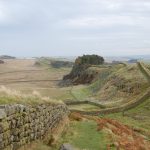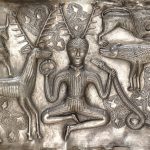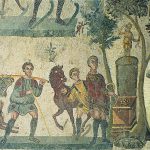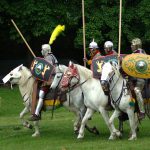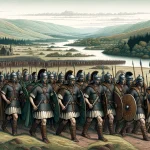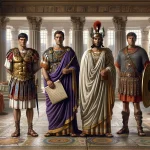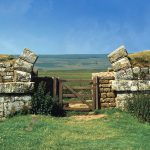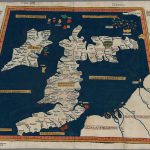Carlisle (Luguvalium) Roman Fort
Flavian Auxiliary Fort (AD 69–96), Legionary Fort and Stanegate Fort
The site of the Roman fort at Carlisle lies partly buried beneath the superstructure of Carlisle Castle Keep. The south-eastern corner-angle and substantial attached lengths of the eastern and southern ramparts, fortunately, have survived intact but buried, in the area between the Castle and the A595 Castle Way Road. These accessible defenses have been subjected to rigorous investigation using the most up-to-date methodologies which has enabled modern archaeologists to piece together a detailed picture of the sequence of forts which were built upon the site, all apparently on the same alignment and of similar size. The actual dimensions of the fort cannot be verified without demolishing the Castle, but restrictions in the local topography would seem to indicate the Roman fort platform covered an area of around 8 acres (c. 3.2 ha).
Pre-Flavian Legionary Encampment at Carlisle (Luguvalium)
It is now known for certain that the Roman site at Carlisle is pre-Agricolan, as dendrochronological dating of timbers used in the southern rampart of the fort proved that they were cut during the Autumn/Winter of AD 72-3. It now appears almost certain that this fort was built and occupied by a vexillation of Legio IX Hispana during the closing campaigns of Quintus Petilius Cerialis against the Brigantian dissident Venutius, ‘to make contact with the sea after an advance from York’ (Frere Britannia p.100). Three large temporary marching camps at Plumpton Head , Crackenthorpe and Rey Cross (Bowes), have all been attributed to the campaigns of this governor and dated sometime around 72/73AD.In further support of this, tiles and pottery sherds bearing the stamp of the Legio IX Hispana have been discovered at Scalesceugh about 5 miles (8km) south of Carlisle, which makes it very likely that a vexillation from this legion was involved in some way with the Flavian presence at Carlisle. The legion was permanently withdrawn from Britain around 120AD.
The Flavian Fort
Excavations conducted by Miss Dorothy Charlesworth in the 1950’s identified the site of a Flavian military enclosure just to the south of the present castle, the medieval structure itself being raised over the north-eastern quadrant of the Roman fortifications. The southern gateway of the fort has been excavated recently by the Carlisle Archaeological Unit, which revealed the timber structure of the gatehouse and its adjoining rampart, the timbers being in a remarkable state of preservation. The fort was defended by a timber rampart and covered about eight acres (3ha). It was obviously located here to guard the strategic crossing over the River Eden. Coinage evidence suggest that the fort underwent some sort of re-occupation c.78-79AD during the Agricolan period, and dendrochronology again suggests that the internal buildings were rebuilt and their timbers replaced during the Autumn/Winter of AD 83-84; this fort was purposefully demolished around 103AD. It had long been thought that the fourth campaign of governor Agricola towards the Tay very likely used Carlisle as the rearward base of the Twentieth Legion during their operations in the south-west of Scotland, but it is certain that this fort remained an important rearward base during the subsequent withdrawal from the Highlands in the 90AD’s.
The Stanegate Fort
Another timber fort having the same dimensions and general layout was built on the same site sometime around 103-5AD, which retained a garrison until well-into the Hadrianic period. The size of the garrison was only gradually reduced, until the site was finally levelled and abandoned during the Antonine period. A passage from one of the Vindolanda writing tablets records that a centurio regionarius, a title associated with the Trajanic Stanegate, was stationed at Luguvalium in 103AD. Even without archaeological evidence, this epigraphy proves that the Stanegate extended at least to Carlisle, which probably represented the western terminus of the original Trajanic frontier system.
The Hadrianic Fortications in the Area
The Carlisle site was obviously eclipsed in importance during the Hadrianic period by the establishment of the large auxiliary cavalry fort at Stanwix (Uxelodunum) which was built astride Hadrian’s Wall only ½-mile to the north-east. To the east of Carlisle for many miles the Wall was built in a narrow guage (i.e. 7’6″) upon a broad foundation (10′ wide), while to the west the narrow wall was continued upon a narrow foundation (around 8′ broad).
A Continued Military Presence
An inscription found at Carlisle dated to the reign of Commodus (176-192AD) refers to the ‘rout of a huge multitude of barbarians’ (see RIB 946 below), and several dedicatory inscriptions dated to the third century record legionary activity at Carlisle.
Another fort, this time of stone, was built on the same site c.200AD by soldiers from the Twentieth Legion, which was finally abandoned sometime between 275-325AD. It seems likely then, that the Carlisle fort retained a legionary cohort until the fourth century, possibly in a logistic capacity, the fort becoming more of a quartermasters complex such as at Corbridge (Corstopitum), which marked the eastern end of the Stanegate frontier. There is no entry for Luguvalium in the Notitia Dignitatum, and interestingly enough, there is no mention of Corbridge (Corstopitum) either.
The Builders of the Carlisle Forts
Legio Sextae Victrix – The Sixth Victorious LegionRIB 3464 - Building inscription of the Sixth Legion
The Sixth Legion (built this).
There may be a medial point between LEG and VI, but this triangular depression, now partially filled with mortar like the letters LE, is more likely to be the result of dressing the stone before it was inscribed. There is no trace of V or VIC for the legion’s cognomen, let alone P F for its titles p(ia) f(idelis), nor was any found on the adjacent stone. This is unusual, but for other instances see RIB 1061, 2162, and probably 1038.
RIB 3466 - Building inscription of the Twentieth Legion Valeria Victrix
… of the Twentieth Legion Valeria Victrix …
[...]
The case is uncertain, but if this were a detachment, not the whole legion (compare RIB 3471), it would be genitive.
Legio Nonae Hispana – The Ninth Spanish LegionLegio Nonae Hispana – The Ninth ‘Hispanic’ Legion
The Garrison Units of Carlisle (Luguvalium) Roman Fort
Ala Augusta Gallorum Petriana – The August Petrian Wing of GaulsRIB 957 - Fragmentary dedication by prefect of Ala Augusta Petriana
… from Luca, prefect of the Cavalry Regiment Augusta Petriana, decorated with a torque, one thousand strong, Roman citizens, gave it as a gift or gave and dedicated it.
AEF ALAE AVGVSTAE
PETRIANAE TORQ ↀ C R
D D
No commentary.
Ala Augusta ob virtutem appellata – The Augustan Wing, so named by reason of their virtue
RIB 946 - Dedication to Hercules
To the virtues of the Roman Hercules, Unconquered, the Founder, for the welfare of the dedicator and his fellow-soldiers, after the slaughter of a band of barbarians by the Cavalry Regiment styled Augusta for valour, Publius Sextanius …, the prefect, from Xanten, willingly and deservedly fulfilled his vow.
VICTI CON[... ...]
TIBVS PRO SẠ[... ...]
COMMILITON[...]
BARBARORV[ ...]
OB VIRTV[...]
P SEXTANIV[ 5... ...]
TAT TRAIA[... ]
The text dates to A.D. 180-92, but before the close of 192 when Commodus identified himself with Hercules. 4.
The Gods of Roman Carlisle
RIB 949 - Dedication to Mars Ocelus and to the Divinity of the Emperor Alexander Augustus, andto Julia Mamaea
“To the god Mars Ocelus and the Divine Spirits of Imperator Alexander Augustus¹ and Julia Mamaea,² Mother of the Camps and of the Senate and of the Fatherland and of the entire Divine House.
NVMINI IMP ALEXANDRI AVG
ET IVL M[...]EAE [...]TR CASTR
[...] DOMVI
[...]
- The nature of this god is dicussed on the RBO page for Caerwent in Monmouthshire, where there are another two stones dedicated to Mars Ocelus (vide RIB 309 & 310).
- The emperor Alexander Severus came to power aged just 13½ after his cousin Elagabalus was murdered by praetorians in March 222AD, and was to rule until his own death at the hands of the usurper Maximinus Thrax at Moguntiacum (Mainz, Germany) in March 235.
- The emperor’s mother, Julia Mamaea, shared the rule with her young son but never endeared herself to the general soldiery, despite the senatorial edict which granted her this grandiloquient title sometime in 227. She was hacked to death by the soldiers of Maximinus whilst clutching the lifeless body of her son Alexander in March 235.
More Altarstones of a Martial Nature at Roman Carlisle
RIB 948 - Altar dedicated to Mars Belatucadrus
To the god Mars Belatucadrus.
Cox, who compiled his text about 1715 (see Birley loc. cit.), said that this altar was found ‘within these few years’. But his information comes from Sir Daniel Fleming’s MS. of 1671 (as Birley agreed, Cumb. Westm. AAST 2nd Ser. lviii (1958) 180) R.P.W.
RIB 950 - Fragmentary inscription
No translation
The recorded text is plainly fragmentary. If these letters were consecutive, then, since the building was of some architectural pretension, marti victori ae[dem, ‘a shrine to Mars Victor’, is a possibility R.P.W.
The most attested deity of Roman Carlisle is the war god Mars who has three dedications, all shared with other deities, to Mars Belatucader (948, altarstone), Mars Ocelus (949) and to Mars Victorius (950). There are two dedications to the Genii or ‘Guardian Spirits’ (944, figurine; 945, altarstone) and another two altarstones to unknown deities (947; 954).
Offerings to the Genii or ‘Guardian Spirits’ at Roman Carlisle
RIB 944 - Dedication to the Genius of the century
To the Genius of the century the century of Bassilius Crescens gave this as a gift.
[.] BASSI[...] CRESCE[...]
DON[ ]ONAVIT
The material is from Shawk Quarry.
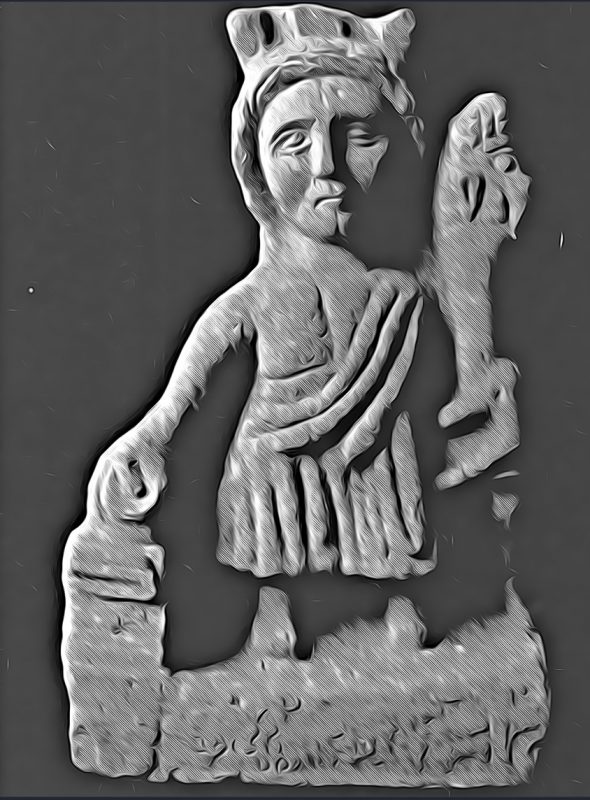
RIB 945 - Altar dedicated to the Genius Loci
To the Genius of this place ..
LO[...]I [...]
- On left side in a projecting niche a seated goddess holds a cornucopia in her righthand and perhaps a patera in her left. On right side stands a Genius with patera inright hand and cornucopia in left. The form of the head, as it remains, suggests thatthe figure may once have worn a turreted crown.
- The goddess might be a seated Mater perhaps holding a large key.
Altarstones to Unknown Deities at Roman Carlisle
RIB 947 - Altar dedicated to Mars Barrex
To Mars Barrex Januarius Ri[.]regipau… willingly and deservedly fulfilled his vow.
REGI IA
NVARI
VS RI[.]
REGIPAV ❦
V S L M
No commentary.
RIB 954 - Fragmentary dedication
… dedicated and gave as a gift the altar and shrine.
ET ARAM ET AE
DICVLAM D D
Now in Tullie House Museum.
In addition, single stones have been found dedicated to the companion-god Cautis (943; pedestal), the demi-god/hero Hercules (946, niche, dated: 180-192AD?), the ‘Mother Goddesses’ (951, base), the god of commerce Mercury (952, relief of Mercury), the Parcae or the ‘Fates’ (953, altarstone), the goddess Concordia by two Roman legions (964a, base), and another altarstone dedicated to ‘all of the Gods and Goddesses’ (964b, dated: 213-222AD).
Votive Offerings to Various Deities
RIB 943 - Dedication to Cautes
To the god Cautes Julius Archietus gave this as a gift.
ARCHIETVS [ ]
- This is the only British dedication to Cautes, and implies that there was a Mithraeum at Carlisle.
- Now in Tullie House Museum.
RIB 951 - Dedication to the Mother Goddesses, the Fates
To the Mother Goddesses, the Fates, for the welfare of Sanctia Gemina.
SANCTIAE GEMINAE
- With a socket on the top probably for a relief of the <span class=”latin”>Matres</span>.
- Now in Tullie House Museum.
RIB 952 - Dedication to Mercury
To the god Mercury C… I… S… (set this up).
C I S
- Relief of Mercury. The pine cone(s) in relief and the associated burial identify the figure as Mercury.
- Now in Tullie House Museum.
- The find-spot associates it with Stanwix, not Carlisle.
RIB 953 - Dedication to the Fates
To the Fates for Bodus (son) of Natalis gladly and deservedly fulfilled his vow.
PRO BO
DO NATALIS
PATER V S
L M
- With plain sides.
Now in Tullie House Museum.
RIB 963 - Fragmentary inscription
Legion.
No commentary.
Tullie House Museum, Carlisle
Though few Roman remains can nowadays be seen in situ, many of the archaeological finds recovered from Carlisle and many of the sites along the Wall are on display at the Tullie House Museum in the centre of the Mediaeval walled town, part of Carlisle’s Public Library and Art Gallery. Exhibits include displays on the day-to-day life in Roman Britain, including tools, ornaments, footware, glass and pottery.
Classical References to Carlisle (Luguvalium) Roman Fort
The name of the town appears twice in the late-second century list of imperial road-routes the Antonine Itinerary. The first appearance occurs in Iter II the longest of the British itinera, entitled “the route from the ‘Entrenchments’ to the seaport of Rutupiae“, which details the road stations between Hadrian’s Wall (the ‘entrenchments’) to Portus Rutupiae (Richborough in Kent). In this particular route the Roman name of Carlisle is recorded as Luguvallo, 12 miles from Netherby (Castra Exploratorum) and 14 miles from Old Penrith (Voreda) Roman Fort. The town is also the northern terminus of the Fifth Itinery, “the route from Londinium to Luguvalium on the Wall, four-hundred and forty-three thousand paces”, this time named Luguvalio and listed 22 miles from Brougham (Brocavum).
The town also appears in the The Ravenna Cosmography of the seventh century as Lagubalumi (R&C#129), between the entries for Old Penrith (Voreda) Roman Fort and Carvoran (Magnis / Magna).
The Roman name for Carlisle then, was Luguvalio, which had been changed by 1106 to Carleol, from which we derive the modern ‘Carlisle’. This is clearly a contraction of the earlier name prefixed by the Welsh word Caer or Cair, meaning ‘fort, fortress’. The word luguvalio is unlikely to be Latin, and would appear to be of British origin, possibly the second element is in some sense derived from “wall” or “Valium” and relates to the Roman wall.
We do not know exactly who Luguvalos was or how the Romano-British town came to be named after him, all we do know is that he was a iron-age noble, probably a high-ranking member of the Carvetii Carvetii[/link_post] tribe who inhabited the countryside hereabouts.
References for Carlisle (Luguvalium) Roman Fort
- Hadrian’s Wall Map and Guide by the Ordnance Survey (Southampton, 1989);
- The Carvetii by Nicholas Higham and Barri Jones (Sutton, London, 1985);
- Hadrian’s Wall in the Days of the Romans by Ronald Embleton and Frank Graham (Newcastle, 1984) pp.311-316;
- The Roman Inscriptions of Britain by R.G. Collingwood and R.P. Wright (Oxford 1965);
- The Romans in Britain An anthology of Inscriptions by A.R. Burn (Oxford 1932);
Roman Roads near Carlisle (Luguvalium) Roman Fort
Stanegate: W (6) to Burgh-by-Sands (Aballava) (Burgh by Sands, Cumbria) SSE (6) to Barrockside Camp Military Way: W (2.5) to Grinsdale Probable Road: NW (14) to Kirkpatrick Stanegate: N (0.5) to Uxelodvnvm (Stanwix, Cumbria) WSW (10) to Old Carlisle (Maglona) (Old Carlisle, Cumbria) Iter II: SSE (5) to Wreay (Cummersdale, Cumbria) Stanegate: ENE (8) to Old Chvrch (Cumbria)
Sites near Carlisle (Luguvalium) Roman Fort
- Luguvalium (Carlisle) Town (1 km)
British Civita - Hadrian's Wall - Milecastle 664 - Stanwix Bank (1 km)
Hadrian's Wall Milecastle - Hadrian's Wall - Fort - Stanwix (Uxelodunum) (1 km)
Hadrian's Wall Fort, Minor Settlement and Roman Bridges - Hadrian's Wall - Milecastle 67 - Stainton (2 km)
Hadrian's Wall Milecastle - Hadrian's Wall - Milecastle 68 - Boomby Gill (2 km)
Hadrian's Wall Milecastle - Hadrian's Wall - Milecastle 65 - Drawdykes (2 km)
Hadrian's Wall Milecastle - Boomby Lane 1 Temporary Camp (3 km)
- Boomby Lane 2 Temporary Camp (3 km)
Marching or Temporary Camp - Hadrian's Wall - Milecastle 64 - Drawdykes (3 km)
Hadrian's Wall Milecastle - Nowtler Hill 1 Temporary Camp (Grinsdale) (4 km)
Marching or Temporary Camp
